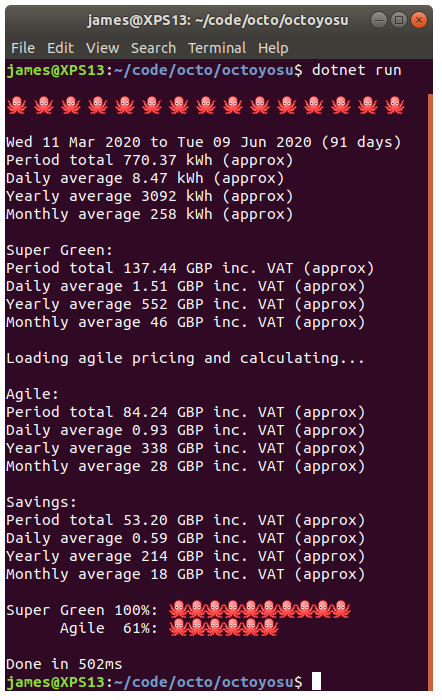Octoyosu is a small command line tool I’ve built that works out how much you would save on the Agile Octopus renewable electricity tariff1. It combines data from an energy logger with historical pricing to calculate savings information (with the Octopus Super Green tariff as a baseline).
This is what it looks like (on Ubuntu LTS):

This is the same output as text:
🐙 🐙 🐙 🐙 🐙 🐙 🐙 🐙 🐙 🐙 🐙 🐙 🐙 🐙 🐙
Wed 11 Mar 2020 to Tue 09 Jun 2020 (91 days)
Period total 770.37 kWh (approx)
Daily average 8.47 kWh (approx)
Yearly average 3092 kWh (approx)
Monthly average 258 kWh (approx)
Super Green:
Period total 137.44 GBP inc. VAT (approx)
Daily average 1.51 GBP inc. VAT (approx)
Yearly average 552 GBP inc. VAT (approx)
Monthly average 46 GBP inc. VAT (approx)
Loading agile pricing and calculating...
Agile:
Period total 84.24 GBP inc. VAT (approx)
Daily average 0.93 GBP inc. VAT (approx)
Yearly average 338 GBP inc. VAT (approx)
Monthly average 28 GBP inc. VAT (approx)
Savings:
Period total 53.20 GBP inc. VAT (approx)
Daily average 0.59 GBP inc. VAT (approx)
Yearly average 214 GBP inc. VAT (approx)
Monthly average 18 GBP inc. VAT (approx)
Super Green 100%: 🐙🐙🐙🐙🐙🐙🐙🐙🐙🐙
Agile 61%: 🐙🐙🐙🐙🐙🐙
Done in 502ms
More information is on my GitHub.
Enjoy!
🐙 💷
Background
At the start of the year I was working out if it was worth getting a smart meter (now that most of the bugs have been ironed out with SMETS2, at least in the South of the country). I calculated that it was definitely worth getting one but unfortunately that is currently on hold (because lockdown).
We’ve used most of the green energy suppliers over the years but we’ve been with Octopus Energy since 2016 as we really like what they’re doing. They are actually innovating and have great tech. We’re currently on the Super Green tariff, which offers “100%” renewable electricity and offset gas2.
Green power is cheaper, as it literally comes from the sky. However, electricity is a bit more complex, as when you use it plays a massive roll in how green it is. When there is a glut of renewable electricity and low demand you will be paid to use it to balance the grid3, but how much?
I have a few devices that measure the whole house power usage over time (I’ve even built my own). So I decided to run the numbers.
It turned out that we could cut a 1⁄3 off of our electricity bill just by getting a smart meter and switching to the Agile Octopus tariff. This involved no new behaviour change (apart from lockdown obviously). However, I originally ran the numbers before lockdown started and it was a similar result.
We already run the dishwasher overnight on a timer (based on the carbon forecast) and run the washing machine in the morning so that we can dry clothes outside on the line4. However, unfortunately we don’t have electric heating or any big batteries to charge, yet.
Your home energy use is over a 1⁄4 of your carbon footprint (probably more in the current climate). Switching your energy supplier is the simplest thing you can do and takes literally minutes. There is no disruption to service and it’s the same end product.
When my kids grow up and ask about why the planet is so fucked I want to be able to tell them that I did everything that I could. Not that I was so lazy I couldn’t even be bothered to spend 10 minutes switching something that has zero impact on me and actually saves us money.
🐙 Header photo by Qijin Xu on Unsplash
- Agile Octopus is a 100% green electricity tariff that regularly pays you to consume electricity. Welcome to the future5! ↩
- If you switch to Agile electricity your gas remains on Super Green so is still offset. ↩
- If you have local generation (e.g. solar panels) and export then you’re never charged for selling back to the grid if the price goes negative. ↩
- Tumble driers are fat energy gluttons so dry naturally outside using the power of the sun and wind if you can. Also, don’t leave the fridge or freezer door open for long. ↩
- If you are not already living in the future then you can switch to Octopus Energy and get £50 credit with this referral link. ↩